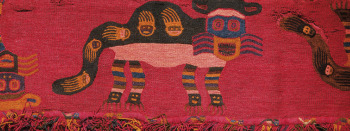Since the end of April, I’ve been waiting for news from Gothenburg, Sweden, about the fate of the Peruvian textiles at the Museum of World Culture there, which are owned by the city.
Discovered on the Paracas peninsula in Peru at the beginning of the 20th century and dated to 2,000 years ago, they are funereal bundles, take from ancient graves. The dead, experts say, were generally buried in a seated position, wrapped in many layers of these woven and embroidered textiles.
 The Gothenburg city council was supposed to vote on Apr. 26 about whether they’d be sent back to South America, in response to Peruvian requests for its cultural patrimony. Peru attended the meeting called by Zahi Hawass in early April (one account here), and put the textiles on its wish list of things to be returned. Hawass has his own account of the meeting, which he says was attended by 25 countries, here.
The Gothenburg city council was supposed to vote on Apr. 26 about whether they’d be sent back to South America, in response to Peruvian requests for its cultural patrimony. Peru attended the meeting called by Zahi Hawass in early April (one account here), and put the textiles on its wish list of things to be returned. Hawass has his own account of the meeting, which he says was attended by 25 countries, here.
But while I haven’t seen any reports in English, a couple of Peruvian news sources have reported that the textiles will be returned to Peru. Here’s one of them, which in translation includes this sentence: “‘Is a moral obligation to restore archaeological relic in the country of origin” said Mrs. Helena Nyhus, from the ranks of Swedish social democracy and president of the cultural section of the city.”
It’s possible that the decision was indeed made, but the announcement was put off until fall, when an exhibition on the textiles at the Museum of World Culture — called “A Stolen World” — closes. The show states its position pretty baldly: “This is the story of how an unscrupulous policy, the illegal commerce and hunting for antiques strip some cultures of their identity.”
It’s also possible that exactly how to return them is an issue. According to a short item last January on the website of the Museum Security Network (here), “the delicate nature of Paracas textiles makes them extremely sensitive to the environment such as light and vibrations. And to move them could mean damage beyond repair.”
As with many issues of cultural patrimony, there’s no easy answer.
And Peru’s bigger dispute is with Yale for artifacts from Machu Picchu.
